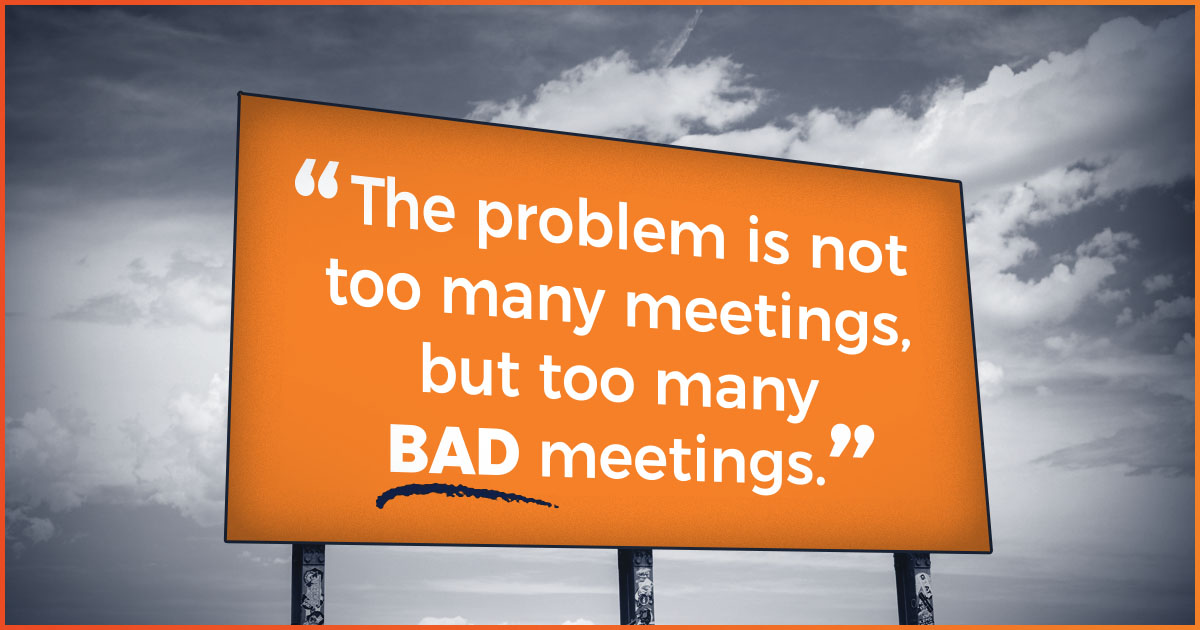
A Wall Street Journal column cited a survey in which 47% of respondents claimed “too many meetings” was the biggest time-waster in their companies — by far the largest response to anything on the list.
In my experience, the problem is not too many meetings, but too many bad meetings.
Meetings are essential because they are where leaders lead and where collaboration happens. Great companies have great meetings and use them to drive their business forward. Bad meetings, however, are much more common and are productivity killers.
So, what makes a meeting good rather than bad? Let’s start with what a bad meeting looks like.
It begins five to 15 minutes late which wastes valuable team-members time and sends a message to the rest of the company that lack of discipline is perfectly acceptable. Once the meeting starts, it consists of lots of discussion, tangents, and trips down rabbit holes that are fun but not especially productive. Few issues will be truly solved and few if any decisions will be made. The phrase “we’ve discussed this to death, we’d better move on” may be heard. And because few issues are really solved, it will probably create the need for more bad meetings.
We’re fond of saying: “If this sounds familiar, don’t worry. You’re not alone. It’s extremely common.” The great news is that there’s help.
The EOS Level 10 Meeting™
Companies running on EOS® (the Entrepreneurial Operating System®) use an extremely effective weekly meeting format that we call the Level 10 Meeting (the name comes from the rating the team gives each meeting — always striving for a perfect 10). This is a weekly meeting that’s 90 minutes long.
This meeting follows five simple rules:
- It’s held on the same day each week
- It’s held at the same time each week
- Follows the same agenda
- Starts on time
- Ends on time
During a Level 10 Meeting, team members in a business running on EOS:
- Take the pulse of their business
- Hold each other accountable for what they promised each other would be done by that meeting
- Smoke out new issues
- Prioritize and solve the issues that are most getting in the way right now
There are two other rules for the Level 10 Meeting:
- During the reporting part of the meeting, no discussion is allowed. Instead, the team drops anything that’s off track, including important issues (those will be handled during the issue-solving part of the meeting). This stops the team from going down rabbit holes early on.
- Issue-solving follows a known, proven process for prioritizing the most important issues, quickly getting to the root cause and then solving them, permanently. The result is that lots of issues get solved.
Every team I’ve helped implement EOS has reported that this meeting change was the first part of the system that they got value from. And every one of those teams reported that they started seeing that step-up in value within the first month of their EOS journey.
It’s no surprise. Team members walk out of their Level 10 Meetings better connected to each other because they all know what every other member of the team is working on and struggling with. This makes the team stronger and more cohesive. They also walk out with lots of issues and roadblocks removed. This frees them up to getting back in their lanes and making significant progress over the next week. And because they got so many issues solved at one time, it means they need fewer meetings, which enables them to get even more done.
If you’re having bad meetings, it’s time you gave the EOS Level 10 Meeting a try!
Previously published on TheTractionGroup blog
Next Steps:
- Watch this helpful video on leading world-class meetings.
- Download a copy of our free eBook, How to Lead World-Class Meetings
- Unlock the EOS Toolbox™ to download a copy of the Level 10 Meeting™ Agenda





